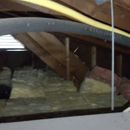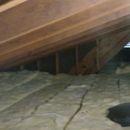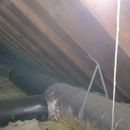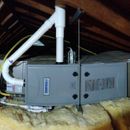How’s my Insulate Attic Plan?
I have a 1950’s Zone 5 house. Since I have sealed combustion furnace/air in attic, I’m considering to insulate the the sloped ceiling (putting the attic space into conditioned space). It is a vented roof with 2×6 roof rafters. I would use:
1. GBA site-built-baffles out of 1″ polyiso (reflective side down) with 2″ air gap between roof sheathing and baffle
2. Plywood gussets connecting 2×6’s to 2×3’s for a depth to take R-38 batt insulation (maybe use two perpendicular layers of R-19 depending on cost)
3. For thermal bridging, I would cover the 2×3’s with another layer of 1″ polyiso (reflective side down).
4. Since there is no space to build out rafters with gussets around the furnace, I would use something like four layers of 1″ polyiso between rafters (1.5″ baffle to sheathing depth) and another layer of 1″ polyiso over the rafters if it fits. (I have access to 1″ polyiso or 2″ EPS.)
Q1: How does this plan sound to you?
Q2: Is it worth the expense to do this if I already have R-19 batts between joists and R-25 over that perpendicular to joists? In other words, have members/others found a benefit to justify such work?
I don’t mind the labor if the benefits will be noticed. Maybe there are some other options/plans of improvement. Thanks
GBA Detail Library
A collection of one thousand construction details organized by climate and house part













Replies
I am guessing that there is more value in air sealing the attic and leaving the existing insulation in place. Your proposed plan will be short of code and still require you to air seal the attic floor.
Steve, thanks for the response. What part is short of code? Also, what would be the recommendation for air sealing the attic floor?
Code requirements vary, but GBA usually shoots for R-49 in CZ5.
Martin has an article on air sealing attics at https://www.greenbuildingadvisor.com/article/air-sealing-an-attic.
You are using short baffles to allow air to move past some attic floor insulation? Or something else (like soffit to ridge baffles)?
Jon R, this is third floor attic. There is currently flimsy maybe polystyrene baffles in place between insulation on floor and roof sheathing (allowing air from 2nd floor attic near soffit vents to make it to 3rd floor ridge vent). If I were to redo with insulation along roof rafters, I'd likely use 1" polyiso along roof rafters in 3rd floor attic. In the 2nd floor attic, the knee walls and floor are insulated.
Whatever the design, don't allow baffles to create a "separate space" between the baffle and the ceiling that doesn't have ventilation. And if you do anyway, make the baffle highly vapor permeable so you aren't creating a cold side vapor barrier.
R806.1 Ventilation required. Enclosed attics and enclosed rafter spaces formed where ceilings are applied directly to the underside of roof rafters shall have cross ventilation for each separate space by ventilating openings protected against the entrance of rain or snow.
The way I see it a conditioned attic just slightly better than what you have IE the worst possible choice.
In my mine the question is how long will you stay in this house?
If the answer is less than 10 years and we assume energy prices are unlikely to triple, from a return on investment point of view air sealing is the only improvement likely to pay off.
If the answer is more than 40 years and we assume energy prices are likely to more than triple, from a return on investment point undoing the poor choice if locating the HVAC system in the attic is clearly the smart move.
There may be a small window in time where the conditioned could be ahead of moving the system but my guess is it is only slightly ahead for a short period of time.
I am not sure I fully understand your plan but it sounds like it will have 2 layers of polyiso with fluffy stuff in between if that is correct it sounds like a foam sandwich and with no way to dry to the interior or exterior stuff in between tends to get moldy.
I dislike conditioned attics and spray foam but if you are determined to have a conditioned attic it seems to me you almost have to have the spray foam to get enough R value in the limited space.
Walta